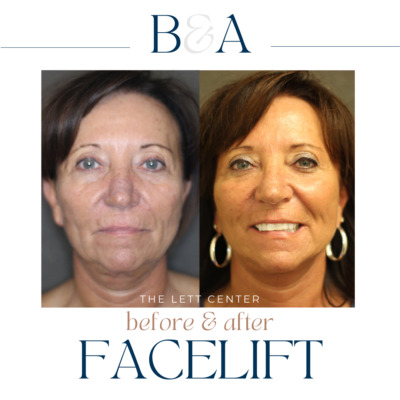Are you thinking about getting a face-lift? If so, you might want to learn more about facelift surgery. Modern facelift techniques have come a long way, and some of them might reverse the effects of aging, such as a rhytidectomy. Some of the most common questions people have about facelifts include:
What is a modern-day facelift & what are the 2022 techniques?
A modern-day facelift uses a lot of traditional techniques that have proven successful while also focusing on best practices, better equipment, and innovative surgical techniques that have taken place during the past few years. For example, the top facelift surgeons in the world will separate the skin from the subcutaneous tissue, allowing the surgeon to position the skin properly without unintentionally shifting subcutaneous tissues out of place. Incision placement, sterile procedure, and complementary techniques all play a role in providing exceptional results. This allows modern surgeons to remove forehead wrinkles, jowls, and lines in the neck while increasing the volume and definition of the jaw and cheeks.
How have facelifts evolved?
Facelifts have evolved significantly during the past 100 years. The earliest facelifts were performed during the early 1900s. These were rudimentary, simple procedures that often led to undesirable side effects and complications. The surgeon would simply remove excess skin and pull anything left closer together; however, this led to a lot of scarring. Now, modern facelifts focus on making as few incisions as possible, minimizing scarring while focusing on minor details that can bring the entire face together.
What was the traditional approach, and why did it change?
The traditional approach to a facelift usually involved focusing on eliminating excess skin around the ears, nose, mouth, and neck. While this is a significant area of focus today, it did not adequately address the underlying structures of the face. When the skin was pulled tight, it often unintentionally shifted subcutaneous fat and muscle tissue, leading to undesirable results. Therefore, modern facelift techniques address a lot of these concerns, increasing patient satisfaction and delivering better results.
How can a modern-day facelift help you reduce wrinkles in lines on your face?
In some cases, wrinkles develop on your face because the skin is too loose. Therefore, the goal is to tighten this skin to help you reduce wrinkle lines on your face. There are several ways to tighten the skin on your face, but it could involve removing excess fat and tissue. In some cases, the surgeon can remove excess skin, tightening the skin that is leftover. When the skin is pulled tight, the wrinkles may go away.
Why are facial muscles tightened to create a youthful appearance?
Facial muscles are commonly tightened during this procedure to create a more youthful appearance. There are muscles underneath the surface of the skin that control the movements of your face. When facial muscles are tightened, the appearance of loose skin is markedly reduced. This can create a more youthful appearance because it could eliminate wrinkles and crease lines on your face.
Why should someone get a facelift, and who should get one?
 There are several reasons why someone might be interested in getting a facelift. For example, you may have sagging skin and your face or neck area. A facelift may help you tighten this skin, removing lines and wrinkles.
There are several reasons why someone might be interested in getting a facelift. For example, you may have sagging skin and your face or neck area. A facelift may help you tighten this skin, removing lines and wrinkles.
You may also feel like you have a sagging jawline. If you feel like your jaw is situated too far below the rest of your face, then a modern facelift might help you.
You might also be interested in a facelift if you notice crease lines near your mouth, nose, and chin. These lines commonly develop with age, but they do not have to be there forever. A facelift may help you reduce some of these creases.
How will you look after the procedure is finished?
The results can vary from person to person, but there are a few common themes regarding how you will look once the procedure is done. You should expect any muscles, fat, or skin along your face to have a much tighter appearance. Some of the wrinkles and lines may have gone away as well. In some situations, excess skin could be removed entirely.
What should you expect during the recovery process?
Once the surgery is finished, your face will be fitted with bandages. That way, swelling will be kept to a minimum, and the recovery time can be shortened. When you wake up, you may notice a bunch of bandages around your face. This is normal.
During the recovery process, you should spend as much time resting as possible. You may have stitches, staples, or clips in your face following the procedure. These are usually removed within a week. It is normal to have some minor discomfort following the procedure, but oral medications are usually enough to handle this.
If you follow the instructions given during the recovery process, your chances of suffering complications should be minimal. There is always a risk that you may have an allergic reaction to the anesthesia. You may also develop an infection because the surface of the skin will be penetrated. A trained, experienced, board-certified surgeon will follow all sterile procedures to keep these risks to a minimum.
What are the benefits of having a facelift?
There are numerous benefits that come with having a facelift. First, you can improve your self-confidence and self-esteem by reducing the signs of aging. You can remove sagging skin that might have collected around your neck and jawline. A facelift can also help you remove creases between your mouth and nose.
A facelift can also help you eliminate a double chin or get rid of jowls. If you have deep wrinkles or age lines, a facelift can remove these issues as well. Everyone is different, so it is important to meet with an experienced surgeon who can help you figure out how this procedure can benefit you.
How much does the surgery cost?
The exact cost of this procedure can vary significantly from person to person. Usually, the procedure costs a few thousand dollars. Some of the biggest factors that will play a role in the cost of this procedure include the time spent in the operating room, any medications required after the procedure, and the cost of anesthesia. If you have questions about your health insurance coverage, you should speak to your insurance provider. If you would like to learn more about how we can make the process more affordable for you, feel free to reach out to us.
How long does the surgery last?
This operation usually takes several hours. If you are having multiple cosmetic procedures done at the same time, the procedure may take a bit longer. Sometimes, other cosmetic procedures are performed at separate appointments. Finally, different facelift techniques can also have an impact on the length of the operation. You should talk about this with your physician during your next appointment.
Other Frequently Asked Questions About a Modern Day Facelift
There are several other common questions people ask about receiving a facelift. These include:
What is the most common age for a facelift?
It is not unusual for people to get a facelift around the age of 60, but there is no “best” age for a facelift. If you are interested in getting a facelift, you should talk with a surgeon about your options.
Does a facelift hurt?
No, a facelift should not hurt because you will be put to sleep during the operation. It is not unusual to feel some minor discomfort following the operation, but oral medication should be enough for you to control your pain.
Is a modern day facelift safe?
Yes, a facelift is safe, as long as it is performed by a board-certified surgeon. That is where our team can help you. We follow all best practices in the field to minimize your risk of complications and side effects.
Facelift Before & After Images →

Contact The Lett Center Today for a Modern Facelift
Are you curious about whether a facelift, also called a rhytidectomy, is right for you? If so, take advantage of modern facelift techniques with trained surgeons from The Lett Center. We work hard to stay on top of the latest advancements in our field because we believe this places us in the best position possible to help you meet your goals. Contact us today to learn more about how we can help you!

